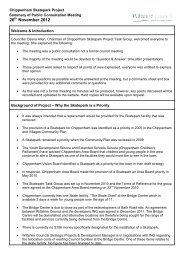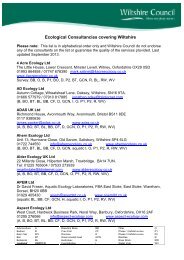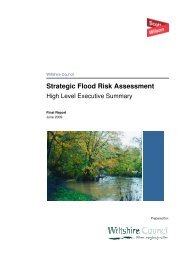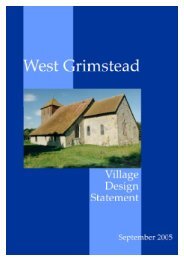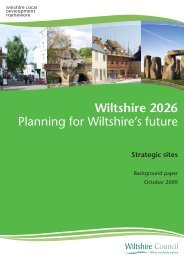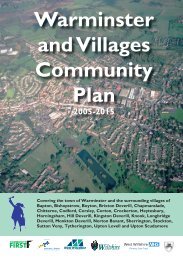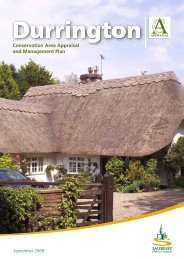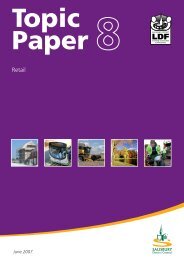Major changes to SWCS 969kb - Wiltshire Council
Major changes to SWCS 969kb - Wiltshire Council
Major changes to SWCS 969kb - Wiltshire Council
- No tags were found...
You also want an ePaper? Increase the reach of your titles
YUMPU automatically turns print PDFs into web optimized ePapers that Google loves.
ProposedChangeReferenceCS REFERENCE CHANGE SOURCEbenefits of community infrastructure and new job opportunitiesMAJ/04 Page 64New paragraphafter Core Policy 5As part of the work <strong>to</strong> develop the Transport Strategy, an ‘Options Assessment Report’ hasbeen prepared. This report sets out a range of deliverable and affordable options and theirconsequential outcomes.In broad terms, the report looks at the difference between two approaches; an “established”approach, which is a continuation of the existing strategy, and a “radical” approach, which ismore in line with current practice of demand management interventions. Both approachesillustrate realistic options between which the eventual strategy will sit.Further consultation on the refinement of the transport strategy will be undertaken. Ultimately,the transport strategy will need <strong>to</strong> support the proposed growth and the ‘Options AssessmentReport’ concludes that a strategy based on the radical option would best enable Salisbury <strong>to</strong>meet the challenges of addressing future growth in travel demand in a sustainable manner.5.53(a) Protecting Retail CentresSalisbury City Centre and the smaller centres of Amesbury, Tisbury, Mere, Wil<strong>to</strong>n andDown<strong>to</strong>n are vulnerable <strong>to</strong> possible edge or out of centre retail and leisure development.Salisbury City Centre is the principal shopping centre within south <strong>Wiltshire</strong>. Amesbury is thesecond largest settlement and functions as a service centre for the communities on thesouthern edge of Salisbury Plain. Other centres at Wil<strong>to</strong>n, Tisbury, Down<strong>to</strong>n and Mere aresmall in scale and perform as local village centres offering little more than essential ‘everyday’requirements <strong>to</strong> a local catchment. Each centre has a Post Office, pharmacy and local <strong>to</strong>p-upfood s<strong>to</strong>re. The Retail and Leisure Needs study identified that the centres are small in scale,appeared <strong>to</strong> be attractive with high quality environments, have a low vacancy rate and did notappear <strong>to</strong>o vulnerable. However, this potentially masks concern in respect of all centres losingessential services and shopping provision, which has been the his<strong>to</strong>ric trend. Rather thanlooking for opportunities for new retailing, which is likely <strong>to</strong> be limited, the challenge is <strong>to</strong>protect the centres that already exist.<strong>Council</strong>’s suggestedwording as a result ofdiscussions at EIP.Page 6 of 70



